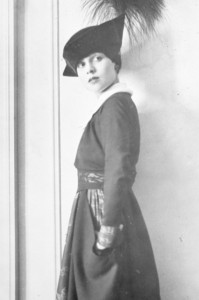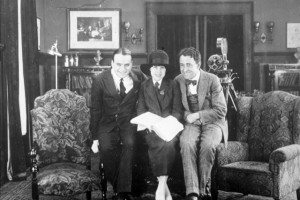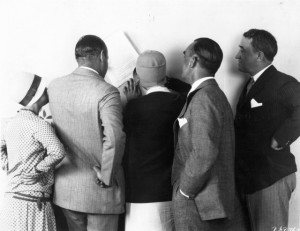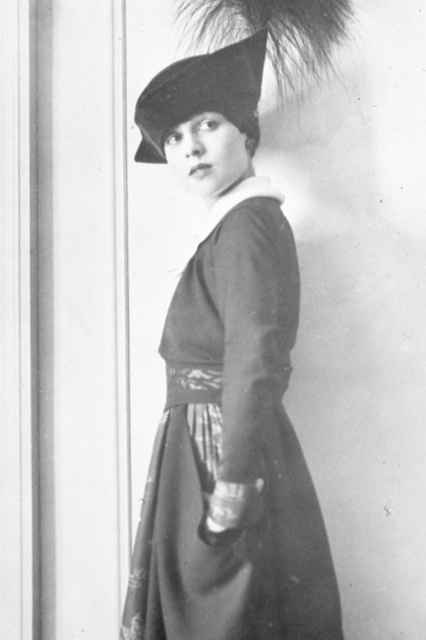by
JoAnne Ruvoli
In 1917, Photoplay reported that “The most important service that Anita Loos has so far rendered the screen is the elevation of the subcaption [sic], first to sanity then to dignity and brilliance combined.” Further, the article went on, Loos had so convinced D. W. Griffith of the value of the intertitle, and he called her “The most brilliant young woman in the world” (148). A prolific writer who appeared in the press in a manner as glamorized as the stars she wrote for, Anita Loos wrote over one hundred and fifty scripts in her thirty years as a Hollywood screenwriter and elevated intertitles to an art. She is best remembered not only for defining the silent era personas of stars like Douglas Fairbanks, Sr., and the Talmadge sisters, Constance and Norma, but for also creating the character of Lorelei Lee in Gentlemen Prefer Blondes, a 1925 novel adapted to films in 1928 and 1953.

Anita Loos. Private Collection.
Bested in script output only by her friend and fellow screenwriter Frances Marion, according to Loos biographer Gary Carey, Loos is credited with elevating intertitles to “a legitimate form of screen humor” (44). Ally Acker agrees, claiming that “the art of the subtitle was born” with the film His Picture in the Papers (1916) from Loos’s script for Douglas Fairbanks, Sr. (1991, 177). Loos sold her first script to Biograph in 1911 and her second script was produced as The New York Hat (1912), directed by D.W. Griffith. One of her most celebrated scripts, The New York Hat was the last film that actress Mary Pickford made for Biograph and contains an early performance by Lionel Barrymore as well as Lillian and Dorothy Gish as extras (Carey 23). When Douglas Fairbanks Sr. arrived at Fine Arts/Triangle Studios, Loos teamed with director John Emerson to write the scripts that led to Fairbanks’s initial film popularity. The combination of her verbal humor with his action-oriented energy is cited by a number of sources as the formula for his success. Carey quotes Loos as recalling that the challenge for her was to find the widest variety of “spots from which Doug could jump.” She satirized this aspect of the Fairbanks character by opening one motion picture with an intertitle that describes him as having “a vaulting ambition which is likely to o’erleap itself and fall on the other side,” followed by a scene of Fairbanks bouncing on a mattress in a bedroom (44).

Anita Loos on set with Douglas Fairbanks and John Emerson. Private Collection.
The Emerson and Loos team parted with Fairbanks in 1918 when he began making his swashbuckling epics, but Loos continued working with Emerson and the two eventually married in 1920. Joseph Schenck, head of Associated First National Pictures, signed contracts with Loos and Emerson to make films for Constance Talmadge. They made Talmadge’s next six films and eventually Loos wrote the 1978 biography of the Talmadge sisters when she thought their successes had been forgotten. The nature of the Loos-Emerson collaboration deserves further study. Gary Carey, as well as Cari Beauchamp and niece Mary Anita Loos write that Emerson insisted on receiving screenplay credit for virtually no contribution to the scripts that Loos wrote and even delegated away much of his directing duties to his assistants (Carey 55; Beauchamp and Loos 2003, 179). Marsha McCreadie writes that Loos had directed Constance Talmadge in Mama’s Affair (1921) and also that she coproduced some of her scripts (1994, 48). Although McCreadie’s claims have not, as yet, been substantiated by the other sources, Emerson’s well-documented hypochondria, philandering, and later institutionalization for schizophrenia raises the question of how much more work Loos may have done to make up for his severe shortcomings.
There is much information available about Loos, but relatively little discussion of her work as a screenwriter. Carey’s biography fills in some of the gaps in Loos’s own entertaining memoirs A Girl Like I, which chronicles her career in early cinema, and the subsequent books Kiss Hollywood Good-by and A Cast of Thousands. Louella Parsons frequently reported on Loos in her New York Telegraph column. Photoplay published a significant number of articles on Loos including one ostensibly written by her father and in 1918 a coauthored series on the craft of “photoplay writing,” which evolved into the 1920 screenwriting manual by Emerson and Loos. The publications sparked a February 1920 exchange with the New York Times about the virtues of using intertitles. There, Loos defends intertitles as basic to the silent scenario writer’s artistry, arguing that “attempts to limit the freedom of screen authors in the use of intertitles almost invariably result in limiting their artistic field” (X7).

Ruth Taylor signs contract for Gentlemen Prefer Blondes (1928), with Anita Loos (L), Jesse Lasky, Hechtor Turnbull, and John Emerson. Private Collection.
With so many of the films Loos wrote available for study, it is surprising that what little analysis there is focuses less on the extant motion pictures than on Loos’s 1925 novel, Gentlemen Prefer Blondes, which started as an amusing reprimand to H.L. Mencken. It was her satire of his behavior in the company of a “witless blonde” that eventually secured her financial success through countless editions, serializations, and theatrical as well as motion picture adaptations (Loos 1998, xix). Critical writing on the 1928 film Gentlemen Prefer Blondes and the 1953 remake directed by Howard Hawks and staring Marilyn Monroe, however, has not yet gone beyond criticism of the talented female writer for the representation of the iconic blond gold digger. Ally Acker, for instance, takes Loos to task for perpetuating the stereotype of the dumb blond who is no more than “tits, ass, and no brains” (1991, 176). New feminist approaches to the stereotype, however, may open up the study of caricature in such a way that a more complex portrait of both Loos and her characters will appear. An important step has been the publication of Anita Loos Rediscovered, which collects motion picture treatments and literary fiction from each era of the writer’s career. Published with the help of Mary Anita Loos, the writer’s niece who holds the bulk of Loos’s papers and manuscripts, this collection may encourage more analysis of a remarkable motion picture career, with special attention to the subtle complexity of Anita Loos’s humor. For most of her adult life, Anita Loos rose at five o’clock each morning to write, and her career in films spanned from 1911 to 1942. Because in addition to motion pictures she continued to write plays and novels, references to her abound in a wide variety of literary histories as well as Hollywood biographies. Just four feet eleven inches tall, she rose to the heights of critical and financial success, from her early stage experiences playing characters like Little Lord Fauntleroy, which earned her just enough money to help support her struggling family, to glamorous, glittering international celebrity.
See also: “Shaping the Craft of Screenwriting: Women Screen Writers in Silent Era Hollywood”
Bibliography
Acker, Ally. Reel Women: Pioneers of the Cinema, 1896 to the Present. New York: Continuum, 1991.
Carey, Gary. Anita Loos: A Biography. New York: Alfred A. Knopf, 1988.
“The Emerson-Loos Way.” New York Times (29 Feb. 1920): X7.
Emerson, John and Anita Loos. How to Write Photoplays. New York: James A. McCann, 1920.
------. “Photoplay Writing.”Photoplay (Feb. 1918): 51-52; (March 1918): 53-54; (April 1918): 81-82, 122; (May 1918): 81-82, 118; (June 1918): 78-79; (July 1918): 88-89,121.
Johnson, Julian. “The Soubrette of Satire: Exposing the Harsh Philosophy of a Little Human Sub-Caption.” Photoplay (July 1917): 27- 28, 148.
Loos, Anita. Anita Loos Rediscovered: Film Treatments and Fiction. Eds. Cari Beauchamp and Mary Anita Loos. Los Angeles: University of California Press, 2003.
------. A Cast of Thousands. New York: Grosset and Dunlap, 1977.
------. Gentlemen Prefer Blondes. 1925; Rpt. New York: Liveright Publishing. 1998.
------. A Girl Like I. New York: Viking, 1966.
------. Kiss Hollywood Good-by. New York: Viking, 1974.
------. The Talmadge Girls. New York: Viking, 1978.
Loos, R. Beers. “Anita’s Dad Spills the Frijoles.”Photoplay (Aug. 1928): 47, 110-113.
McCreadie, Marsha. The Women Who Write the Movies: From Frances Marion to Nora Ephron. Secaucus, N.J.: Carol Pub. Group, 1994.
Archival Paper Collections:
Anita Loos clippings file. Academy of Motion Picture Arts and Sciences, Margaret Herrick Library.
Anita Loos Collection. Boston University, Howard Gotlieb Archival Research Center.
Anita Loos papers, 1912-1915; 1956-1979. Academy of Motion Picture Arts and Sciences, Margaret Herrick Library.
Anita Loos papers, 1917-1981. New York Public Library, Billy Rose Theatre Division.
Anita Loos scripts. Academy of Motion Picture Arts and Sciences, Margaret Herrick Library.
Interview with Anita Loos. May 1971. Time-Life History of American Movies. American Film Institute.
Reminiscences of Anita Loos. July 14, 1971. Columbia University, Rare Book and Manuscript Library
Reminiscences of Anita Loos. December 2, 1974. Columbia University, Rare Books and Manuscript Library
Filmography
A. Archival Filmography: Extant Titles:
1. Anita Loos as Screenwriter
My Baby. Dir.: Frank Powell, sc.: Anita Loos (Biograph Co. US 1912) cas.: Mary Pickford, W. Chrystie Miller, Henry B. Walthall, Lionel Barrymore, Lillian Gish, si, b&w, 35mm. Archive: George Eastman Museum, Library of Congress.
The New York Hat. Dir.: D.W. Griffith, sc.: Anita Loos (Biograph Co. US 1912) cas.: Mary Pickford, Claire McDowell, Mae Marsh, Lionel Barrymore, Lillian Gish, Dorothy Gish, Jack Pickford, si, b&w, 16mm, 35mm. Archive: Cinémathèque Québécoise, Cinemateca do Museu de Arte Moderna, Svenska Filminstitutet , George Eastman Museum, Israel Film Archive/Jerusalem Cinematheque, Library of Congress, Museum of Modern Art, National Archives & Records Administration, Library and Archives Canada, BFI National Archive, UCLA Film & Television Archive, UC Berkeley Art Museum & Pacific Film Archive, Lobster Films.
The Musketeers of Pig Alley. Dir.: D.W. Griffith, sc.: Anita Loos, D.W. Griffith (Biograph Co. US 1912) cas.: Lillian Gish, Dorothy Gish, Elmer Booth, Lionel Barrymore, si, b&w. Archive: Library of Congress, Cinémathèque Québécoise, Cinemateca do Museu de Arte Moderna, Svenska Filminstitutet , Museum of Modern Art, George Eastman Museum, Academy Film Archive, UCLA Film & Television Archive, Cineteca del Friuli, Centre National du Cinéma et de l’Image Animée, Museo Nazionale del Cinema, EYE Filmmuseum, National Film and Sound Archive of Australia, Danske Filminstitut, Münchner Stadtmuseum, Cinemateca Romana, Cinémathèque Française, Fundación Cinemateca Argentina.
His Hoodoo. Dir. Edward Dillon, sc.: Anita Loos (Biograph Co. US 1913) cas.: Charles Murray, Gertrude Bambrick, si, b&w. Archive: Museum of Modern Art.
The Lady in Black. Dir.: Dell Henderson, sc.: Anita Loos (Biograph Co. US 1913) cas.: Ed Dillon, Dorothy Gish, Gertrude Bambrick, si, b&w. Archive: Museum of Modern Art.
The Power of the Camera. Dir.: Dell Henderson, sc.: Anita Loos (Biograph Co. US 1913) cas.: Charles Murray, Dell Henderson, si, b&w. Archive: Museum of Modern Art.
The Wedding Gown. Dir.: James Kirkwood, sc.: Anita Loos (Biograph Co. US 1913) cas.: Gertrude Robinson, Marshall A. Neilan, Antonio Moreno, Kate Bruce, H.S. Mack, si, b&w, 35mm, 2 reels. Archive: Library of Congress, Museum of Modern Art.
A Duel for Love or The Sisters. Dir.: William Christy Cabanne, sc.: Anita Loos (Majestic Motion Picture Co. US 1914) cas.: Dorothy Gish, Lillian Gish, Elmer Clifton, si, b&w, 35mm. Archive: Library of Congress.
For Her Father’s Sins. Dir.: John B. O’Brien, sc.: Anita Loos (Majestic Motion Picture Co. US 1914) cas.: Blanche Sweet, Billy West, Wallace Reid, Al Filson, si, b&w, 35mm. & 16mm., 2 reels. Archive: Library of Congress.
American Aristocracy. Dir.: Lloyd Ingraham, sc.: Anita Loos (Fine Arts Film Co. US 1916) cas.: Douglas Fairbanks, Jewel Carmen, Charles de Lima. si, b&w, 16mm, 28mm, & 35mm. Archive: George Eastman Museum, Library of Congress, UCLA Film & Television Archive, Academy Film Archive.
The Halfbreed. Dir.: Allan Dwan, sc.: Anita Loos (Fine Arts Film Co. US 1916) cas.: Douglas Fairbanks, Alma Reubens, Sam De Grasse, Tom Wilson, Jewel Carmen, si, b&w, 16 & 35mm, 5 reels. Archive: Library of Congress, Centre National du Cinéma et de l’Image Animée.
His Picture in the Paper. Dir.: John Emerson, sc.: Anita Loos (Fine Arts Film Co. US 1916) cas.: Douglas Fairbanks, Clarence Handyside, Renée Boucicault, Jean Temple, Loretta Blake, Erich Von Stroheim. si, b&w, 16mm. Archive: Centre National du Cinéma et de l’Image Animée, George Eastman Museum, Library of Congress, Academy Film Archive, BFI National Archive.
Intolerance. Dir./sc.: D.W. Griffith, ttl.: Anita Loos (Wark Producing Corp. US 1916) cas.: Lillian Gish, Fred Turner, Robert Harron, Mae Marsh, Monte Blue, Bessie Love, Eugene Pallette, Constance Talmadge, si, b&w. Archive: Bulgarska Nacionalna Filmoteka, Cinémathèque Québécoise, Cinémathèque Royale de Belgique, Svenska Filminstitutet , National Film and Sound Archive of Australia, Cineteca del Friuli, Münchner Stadtmuseum, Filmoteka Narodowa, George Eastman Museum, Gosfilmofond, Library of Congress, Museum of Modern Art, BFI National Archive, EYE Filmmuseum, Österreichisches Filmmuseum, Cineteca Nazionale, Fondazione Cineteca Italiana, Cinemateca Romana, UCLA Film & Television Archive, Academy Film Archive, Filmoteca Española, Harvard Film Archive, Library and Archives Canada, Danske Filminstitut, Museo Nazionale del Cinema, UC Berkeley Art Museum & Pacific Film Archive, Jugoslovenska Kinoteka, Anthology Film Archives, Lobster Films.
Wild and Woolly. Dir.: John Emerson, sc.: Anita Loos (Douglas Fairbanks Pictures Corp. US 1917) cas.: Douglas Fairbanks, Eileen Percy, Ruth Allen. si, b&w, 16mm, 35mm. Archive: Cinémathèque Royale de Belgique, George Eastman Museum, Museum of Modern Art, Cineteca del Friuli, UCLA Film & Television Archive, UC Berkeley Art Museum & Pacific Film Archive, National Film and Sound Archive of Australia, Lobster Films.
Stranded. Dir.: Phil Rosen, sc.: Anita Loos, Frances Guihan (Sterling Pictures Corp. US 1927) cas.: Shirley Mason, William Collier, Jr., John Miljan, Florence Turner, Gale Henry, Shannon Day, Lucy Beaumont, Rosa Gore, si, b&w, 35mm, 16mm. Archive: Library of Congress.
2. Anita Loos as Co-Screenwriter
The Social Secretary. Dir.: John Emerson, sc.: Anita Loos, John Emerson, Alfred Huger Moses, Jr. (Fine Arts Film Co. US 1916) cas.: Norma Talmadge, Kate Lester, Helen Weir, Erich Von Stroheim, si, b&w, 16mm, 28mm, 35mm. Archive: Cinemateca do Museu de Arte Moderna, George Eastman Museum, Library of Congress, BFI National Archive, UCLA Film & Television Archive, Academy Film Archive.
The Matrimaniac. Dir.: Paul Powell, sc.: Anita Loos, John Emerson (Fine Arts Film Co. US 1916) cas.: Douglas Fairbanks, Constance Talmadge, Wilbur Higbee (Higby), si, b&w, 16mm, 28mm, 35mm. Archive: George Eastman Museum, Library of Congress, Cineteca Nazionale, UCLA Film & Television Archive, Academy Film Archive.
The Americano. Dir.: John Emerson, sc.: Anita Loos, John Emerson (Fine Arts Film Co. US 1917) cas.: Douglas Fairbanks, Alma Rubens, Spottiswoode Aitken, si, b&w, 16mm, 35mm. Archive: George Eastman Museum, Library of Congress, Fondazione Cineteca Italiana, UCLA Film & Television Archive.
Reaching for the Moon. Dir.: John Emerson, sc.: Anita Loos, John Emerson (Douglas Fairbanks Picture Corp. US 1917) cas.: Douglas Fairbanks, Richard Cummings, Millard Webb, Eileen Percy, Eugene Ormonde, Frank Campeau. si, b&w, 16mm. Archive: Cinémathèque Royale de Belgique, Cineteca del Friuli, Museum of Modern Art, George Eastman Museum.
A Temperamental Wife. Dir.: David Kirkland, sc.: Anita Loos, John Emerson (Constance Talmadge Film Co. US 1919) cas.: Constance Talmadge, Wyndham Standing, Ben Hendricks, Eulalie Jensen, si, b&w, 35mm. Archive: Library of Congress, BFI National Archive.
Under the Top. Dir.: Donald Crisp, sc.: Anita Loos, John Emerson, Gardner Hunting (Famous Players-Lasky Corp. US 1919) cas.: Fred Stone, si, b&w, 35mm. Archive: Library of Congress, UCLA Film & Television Archive.
A Virtuous Vamp. Dir.: David Kirkland and Sidney Franklin, sc.: Anita Loos and John Emerson (Constance Talmadge Film Co. US 1919) cas.: Constance Talmadge, Belle Daube, Jack Kane, si, b&w, orig. 5 reels [incomplete]. Archive: Museum of Modern Art.
The Branded Woman. Dir.: Albert Parker, sc.: Anita Loos, Albert Parker, Burns Mantle (Norma Talmadge Film Co., US 1920) cas.: Norma Talmadge, Percy Marmont, Vincent Serrano, si, b&w, 35mm. Archive: Library of Congress.
In Search of a Sinner. Dir.: David Kirkland [FIAF lists David Kirkman], sc.: Anita Loos and John Emerson (Constance Talmadge Film Co. US 1920) cas.: Constance Talmadge, Rockcliffe Fellowes, Corliss Giles, si, b&w, 35mm. Archive: Library of Congress, UCLA Film & Television Archive.
The Love Expert. Dir.: David Kirkland, sc.: Anita Loos, John Emerson (Constance Talmadge Film Co., US 1920) cas.: Constance Talmadge, John Halliday, Arnold Lucy, Natalie Talmadge, Fan Bourke, Nellie Parker Spaulding, Marion Sitgreave, James Spottswood, David Kirkland, Edward Kepler, si, b&w, 35mm. Archive: Library of Congress, BFI National Archive.
Two Weeks. Dir.: Sidney A. Franklin, sc.: Anita Loos, John Emerson (Joseph M. Schenck Productions US 1920) cas.: Constance Talmadge, Conway Tearle, Reginald Mason, si, b&w, 35mm. Archive: Library of Congress, UCLA Film & Television Archive.
Mama’s Affair. Dir.: Victor Fleming, sc.: Anita Loos, John Emerson (Constance Talmadge Film Co. US 1921) cas.: Constance Talmadge, Effie Shannon, Katherine Kaelred, George Le Guere, Kenneth Harlan, Gertrude Le Brandt. si, b&w, 35mm. Archive: Library of Congress.
Learning to Love. Dir.: Sidney A. Franklin, sc.: Anita Loos , John Emerson (Joseph M. Schenck Productions US 1925) cas.: Constance Talmadge, Antonio Moreno, Emily Fitzroy, si, b&w, 35mm. Archive: Library of Congress.
3. Anita Loos as Actress
Photoplay Screen Supplement. Unidentified Issue No. 2. (Photoplay Magazine US 1918) cas.: Jack Kirkwood, Montague Love, Anita Loos, Mary Miles Minter, John Emerson, si, b&w, 35mm. Archive: Library of Congress.
Camille or The Fate of a Coquette. Dir.: Ralph Barton (Ralph Barton Productions US 1926) cas.: Anita Loos, Sinclair Lewis, Paul Robeson, Charles G. Shaw, Charles Chaplin. si, b&w, 16mm. Archive: Library of Congress.
B. Filmography: Non-Extant Film Titles:
1. Anita Loos as Screenwriter
The Earl and the Tomboy, 1912; He Was a College Boy, 1912; The Road to Plaindale, 1912; All for Mable, Man in the Couch, 1913; All on Account of a Cold, 1913; Binks Runs Away, 1913; A Bunch of Flowers, 1913; A Cure for Suffragettes, 1913; The Deacon’s Whiskers, 1913; Fall of the Hicksville Finest, 1913; A Fallen Hero, 1913; The Fatal Deception, 1913; A Fireman’s Love, 1913; Gentlemen Thieves, 1913; A Girl like Mother, 1913; The Great Motor Race, 1913; A Hicksville Epicure, 1913; A Hicksville Romance, 1913; Highbrow Love, 1913; His Awful Vengeance, 1913; A Horse on Bill, 1913; How the Day Was Saved, 1913; The Making of a Masher, 1913; The Mayor Elect, 1913; The Mother, 1913; Path of True Love, 1913; The Queen of the Carnival, 1913; The Suicide Pact, 1913; Two Women, 1913; Unlucky Jim, 1913; The Wallflower, 1913; When a Woman Guides, 1913; The Widow’s Kids, 1913; Yiddish Lover, 1913; At the Tunnel’s End, 1914; A Balked Heredity, 1914; A Blasted Romance, 1914; The Chieftain’s Daughter, Some Bull’s Daughter, 1914; The Deadly Glass of Beer, 1914; The Fatal Curve/Izzy and His Rival, 1914; The Fatal Dress Suit, 1914; A Flurry in Art, 1914; The Girl in the Shack, 1914; He Went to the Dogs, 1914; A Hicksville Reformer, 1914; His Hated Rivals/A Corner in Hats, 1914; His Rival, 1914; How They Met, 1914; The Last Drink of Whiskey, 1914; A Life and Death Affair, 1914; The Meal Ticket, 1914; The Million Dollar Bride, 1914; Mortimer’s Millions, 1914; Nearly a Burglar’s Bride, 1914; Nell’s Eugenic Wedding, 1914; Nellie, the Female Villain, 1914; A No Bull Story, 1914; The Old Oak Tree, 1914; The Saving Presence, 1914; The School of Acting, 1914; The Sensible Girl, 1914; The Stolen Masterpiece, 1914; The Style Accustomed, 1914; The Suffering of Susan, 1914; Where the Road Parts, 1914; The White Slave Catchers, 1914; The Burlesquers, 1915; Cost of a Bargain, 1915; The Fatal Finger Prints, 1915; The Fatal Fourth, 1915; How to Keep a Husband, 1915; Mixed Values, 1915; Mountain Bred, 1915; Pennington’s Choice, 1915; Sympathy Sal, 1915; The Tear of a Page, 1915; Wards of Fate, 1915; Calico Vampire, 1916; A Corner in Cotton, 1916; French Milliner, 1916; Laundry Liz, 1916; The Little Liar, 1916; Macbeth, 1916; Stranded, 1916; The Wharf Rat, 1916; Wild Girl of the Sierra, 1916; Daughter of the Poor/The Spitfire, 1917; Publicity Madness, 1927.
2. Anita Loos as Co-Screenwriter
Down to Earth, 1917; In Again, Out Again, 1917; Come on In, 1918; Goodbye Bill, 1918; Hit the Trail Holiday, 1918; Let’s Get a Divorce, 1918; Getting Mary Married, 1919; The Isles of Conquest, 1919; Oh, You Women!, 1919; The Perfect Woman, 1920; Dangerous Business, 1921; A Woman’s Place, 1921; Polly of the Follies, 1922; Red Hot Romance, 1922; Dulcy, 1923; Three Miles Out, 1924; Gentlemen Prefer Blondes, 1928.
C. DVD Sources:
The Social Secretary. DVD/VHS (Grapevine Video)
American Aristocracy. DVD. (Grapevine Video US 2005)
Griffith Masterworks: Biograph Shorts (1908-1914. DVD. (Kino Video US 2002) - contains The New York Hat (1912) and The Musketeers of Pig Alley (1912).
Douglas Fairbanks: A Modern Musketeer. DVD. (Flicker Alley US 2008) - contains His Picture in the Papers (1916).
D.W. Griffith Years of Discovery, 1909-1913. DVD. (Image Entertainment US 2002) - contains The New York Hat (1912)
D. Streamed Media:
His Picture in the Papers (1916) is streaming online via Kanopy
Intolerance (1916) is streaming online via Kanopy
Reaching for the Moon (1917) is streaming online via Kanopy
The New York Hat (1912) is streaming online via Amazon Video
Credit Report
The following extant films are incomplete: The Wedding Gown, For Her Father’s Sins, and The Halfbreed.
Sources differ on whether or not Anita Loos was involved in scripting The Musketeers of Pig Alley (1912). Many sources just credit D.W. Griffith.
Citation
Ruvoli, JoAnne. "Anita Loos." In Jane Gaines, Radha Vatsal, and Monica Dall’Asta, eds. Women Film Pioneers Project. New York, NY: Columbia University Libraries, 2013. <https://doi.org/10.7916/d8-zhbt-5730>




